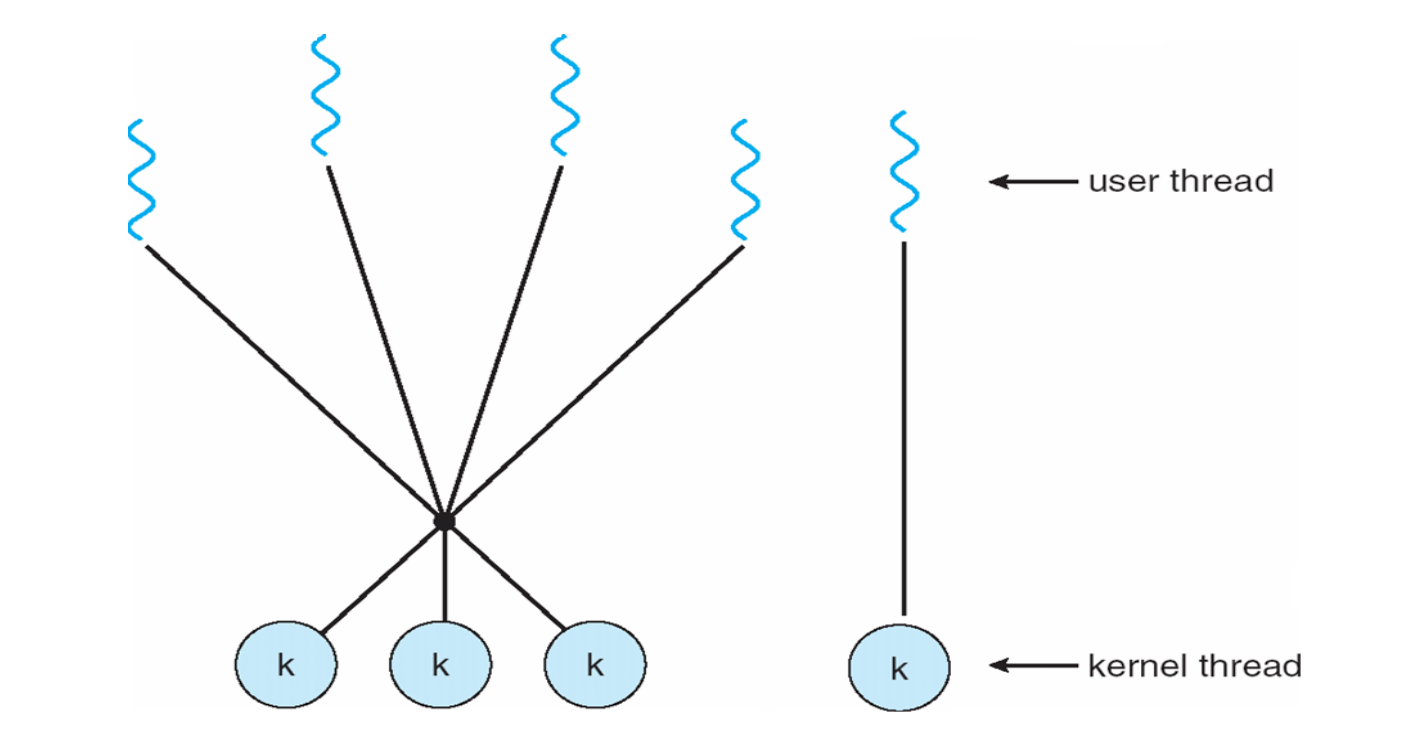Threads¶
- Multiple execution units with a process
- 栈和pc不能共享

Definition¶
-
A thread is a basic unit of execution within a process.
-
Each thread has its own
- thread ID
- program counter
- register set
- Stack
- It shares the following with other threads within the same process
- code section
- data section
- the heap (dynamically allocated memory): 通过指针访问,不在cache里比较慢
-
open files and signals
-
Concurrency: A multi-threaded process can do multiple things at once
-
Advantages of Threads
-
Economy
- Creating a thread is cheap
如果已经有了一个线程,那么我们创建新的线程只需要给它分配一个栈。Code,data,heap 都已经在内存里分配好了。
- Context switching between threads is cheap
Cache is hot, no need to cache flush.
-
Resource Sharing Threads naturally share memory
不需要 IPC。
- Having concurrent activities in the same address space is very powerful
-
Responsiveness
如在 web server 中,一个线程在等待 I/O,当有请求来时就再分配一个线程去处理。(进程也可以,但是代价更大)
-
Scalability
- multi-core machine
-
Drawbacks of Threads
-
weak isolation between threads
如果有一个线程出错,那么整个进程都会出错。 lead to process-based concurrency
-
thread间没有隔离,保护措施不够
-
Typical challenges of multi-threaded programming
-
Deal with data dependency and synchronization
- Dividing activities among threads
- Balancing load among threads
- Split data among threads
- Testing and debugging
User Threads vs. Kernel Threads¶
如果内核不知道你这个 user thread,完全在 user space 执行,就是 user space-based thread; 如果内核知道你这个 user thread,就是 kernel-based thread。
-
Many-to-One Model
-
优点:multi-threading is efficient and low-overhead.
- 缺点:内核只有一个线程,无法发挥 multi-core 的优势;一旦一个线程被阻塞,其他线程也会被阻塞。

- One-to-One Model
把线程的管理变得很简单,管理很简洁,现在 Linux,Windows 都是这种模型。硬件便宜了
缺点:overhead大

- Many-to-Many Model
m to n 线程,折中。缺点是太复杂。

- Two-Level Model
可以选择 many to many 或者 one to one。

- implementation
-
Java Threads / Kernel Threads: In modern JVMs, application threads are mapped to kernel threads

Threading Issues¶
- Semantics of
fork()andexec()
如果一个线程调用了 fork(),可能发生两种情况:只复制调用线程,或者复制所有线程。
Some OSes provide both options. In Linux the first option above is used
因为大部分时候 fork 之后会接 exec,抹掉所有的数据,因此直接复制调用线程就可以了。
- Signals
-
multiple options: signal给调用线程/所有线程/certain线程/指定一个线程接收所有signal
-
Linux实现:提供多个接口自己选 dealing with threads and signals is tricky but well understood with many tutorials on the matter and man pages
- Safe Thread Cancellation
- 可能出现问题:取消了一个正在工作的线程
- two approach
- Asynchronous cancellation:立即终止
- problem: 可能会导致inconsistent state或synchronization problem,Absolutely terrible bugs lurking in the shadows
- Deferred cancellation: A thread periodically checks whether it should terminate 线程会自己进行周期性检查,如果取消掉不会影响系统的稳定性,就把自己取消掉。
- problem: the code is cumbersome due to multiple cancellation points
- Invoking thread cancellation requests cancellation, but actual cancellation depends on thread state

Linux Threads¶
In Linux, a thread is also called a light-weight process (LWP)
The clone() syscall is used to create a thread or a process

TCB 用来存储线程的信息,Linux 并不区分 PCB 和 TCB,都是用 task_struct 来表示。
- single-threaded process vs multi-threaded process.
- 共享内容:通过指针指对应结构体

- PID 如果和 LWP 相同,说明这个进程只有这一个线程。如果不相同,说明进程有多个线程,此时进程的 PID 是主线程的 LWP。

- A process is
- either a single thread + an address space, PID is thread ID
-
or multiple threads + an address space, PID is the leading thread ID
-
Threads with Process – What is shared
mm_structis shared,task_struct,pid,stackandcommare not shared.


- One task in Linux
- Same task_struct (PCB) means same thread
- One user thread maps to one kernel thread
- But actually, they are the same thread
- Can be executed in user space: User code, user space stack
- Can be executed in kernel space: Kernel code, kernel space stack
例如我们使用了一个系统调用,线程切换到内核模式,相当于是用户线程对应的内核线程在执行,此时就使用内核空间的栈。
- example
